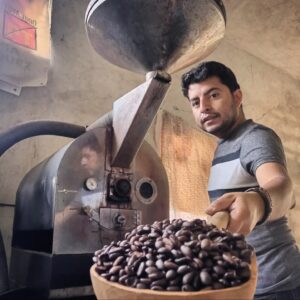Description
Hidden among the montane cloud forests and the mist that characterizes the Sierra Norte of Puebla, one of the region's most well-known trees, the capulín, is abundant. Thanks to this characteristic of the area, the farm is given the Nahuatl name Capolcuahutitan, which means “place in the middle of the capulín trees” (capollin: capulín, cuahuitl: tree, and titan: place in the middle of).
This plot has been in constant production for 25 years, starting with the planting of the Typica and Mondo Novo varieties, complemented by chalahuite trees for shade. Over time, these were progressively replaced by new medium-sized varieties, especially Caturra and Garnica.
However, in the last 10 years, both varieties have been vulnerable to the advance of rust and the worsening of the dry season in the region, which affects the quality of the harvest. Faced with this new challenge, new rust-resistant and high-temperature-resistant varieties are being sought, such as Costa Rica 95 and Oro Azteca, the latter of which has given us the best yields.
The new coffee plants have been sourced from our own nursery for the past 7 years. We not only have the two aforementioned varieties, but also produce two other new ones: Colombiana and Sarchimor. Additionally, Jinicuil seedlings are being produced as a substitute for the chalahuite trees, which have recently been affected more frequently each year by an insect plague that eats the foliage and dries them out.
Throughout the year, 3 weeding sessions are carried out with a machete (one every 4 months), and fertilizer is applied twice a year: once just before the first harvest (December-January) and another between June-July after the first summer rains. The formula used is a physical mixture of 18-12-06 in granulated form, along with the application of dolomite lime every 3 years. In the ravine areas of the farm, each row has individual terraces for each plant.
Pruning is done after the harvest season with pruning shears, removing dry and diseased parts; or when the damage is greater or the plant has low productivity since its first planting, it is removed by cutting at the base of the stem (recepa). When the shoots of the recepa coffee plant sprout, thinning is done, keeping 2 or 3 shoots. Only two recepas are allowed during the coffee plant's lifecycle.
Starting with the manually conducted collection, care is taken to ensure the cherry is uniformly ripened and that the loads are handled with care and pulped as soon as possible; this way, no runoffs form, and the fruit does not ferment. The pulping and mechanical demucilaging processes are carried out simultaneously through an ecological module.
On a clean concrete floor, the freshly washed coffee is spread and stored in a clean and dry room. This process is repeated until the bean, when bitten, has a rigid hardness, the protective covering can be removed without the parchment, and it has a coloration similar to cow horns.
When these conditions are met, the dried coffee is passed through a fan and then through a sieve to remove excess parchment, small, hollow, and broken beans. Once finished, the parchment coffee is stored in clean jute sacks sewn by hand with raffia thread and then placed on pallets, avoiding contact with the ground and the walls.
Farm Information
-
Farm NameCapolcuahutitan
-
FarmerElmer Natanael Sánchez Cortés
-
Altitude1080 - 1120
Score
-
Score87.05
Lot Information
-
Year2024
-
Processing SystemWashed
-
VarietyOro Azteca, Costa Rica 95




![COE Mexico 2024 – wet – Capolcuahutitan-7 COE Mexico 2024 - wet - Capolcuahutitan]](https://farmdirectory.cupofexcellence.org/wp-content/uploads/2024/06/COE-Mexico-2024-wet-Capolcuahutitan-7-225x300.jpg)

